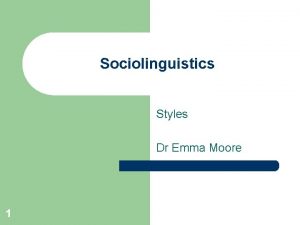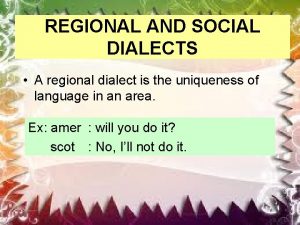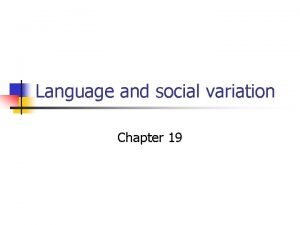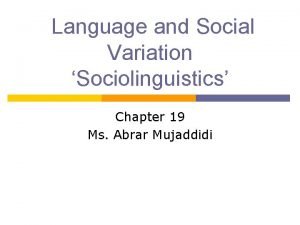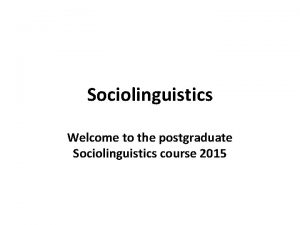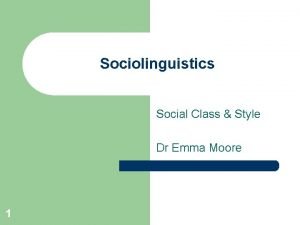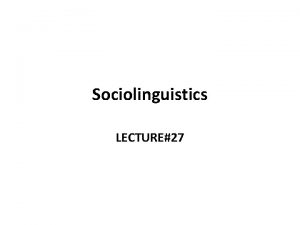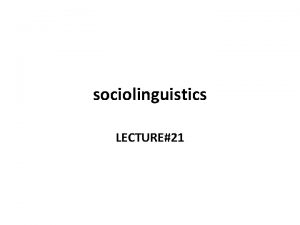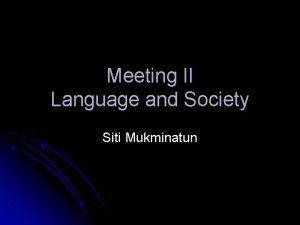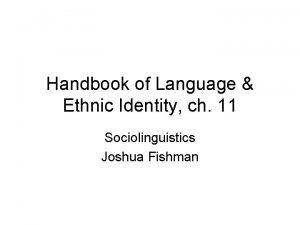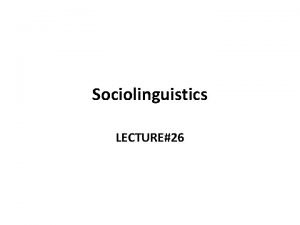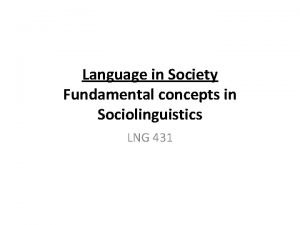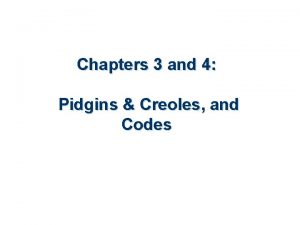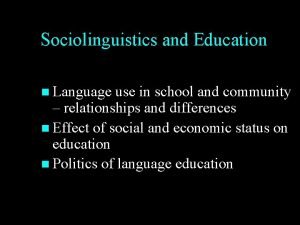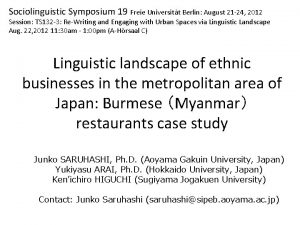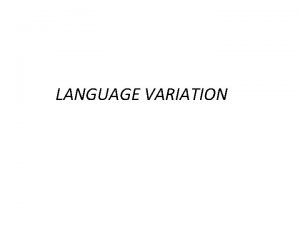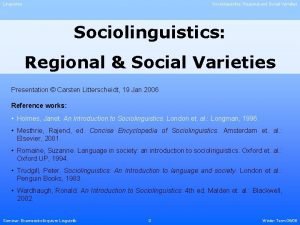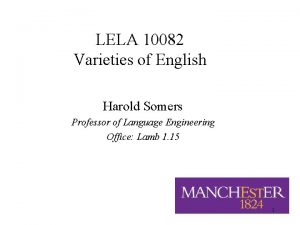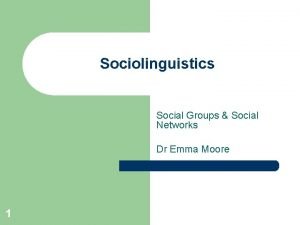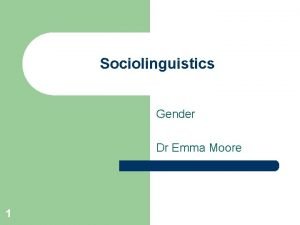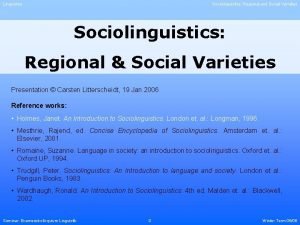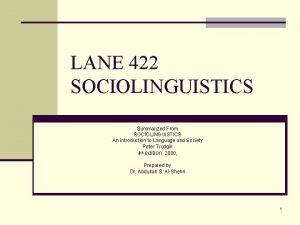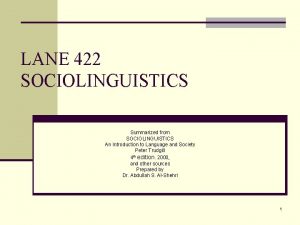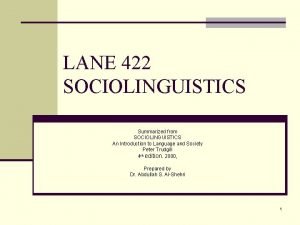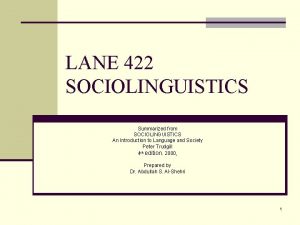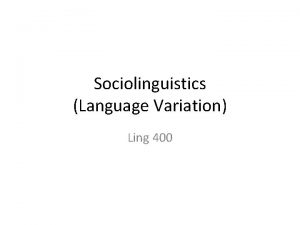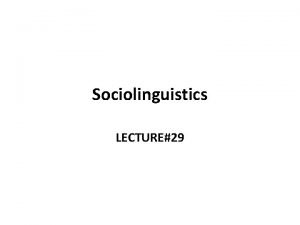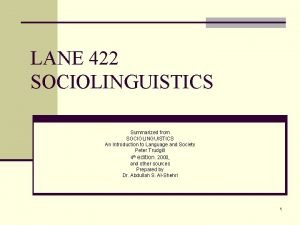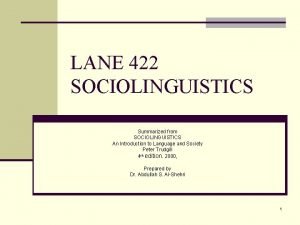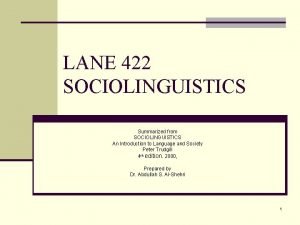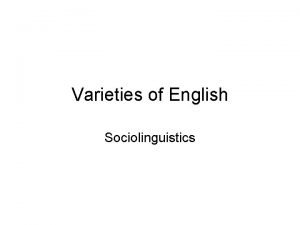Sociolinguistics Social Class Style Dr Emma Moore 1



























- Slides: 27

Sociolinguistics Social Class & Style Dr Emma Moore 1

Contents l l What are the concerns of sociolinguists (and how do they differ from those of dialectologists)? How do sociolinguists define their ‘sampling environment’? – – l 2 Studying social variation Studying stylistic variation What research issues do sociolinguists need to think about?

Regional dialectology l The relationship between dialectology and sociolinguistics – l Both concerned with recording “real language” Traditional dialectology – Linguistic archaeology? l l 3 Preserving older stages of the language Preserving traditional, rural dialects

Criticisms of traditional dialectology Representativeness l Location – l Relatively formal Survey methods – 4 1 -2 informants per locality Context – l NORMs Sample size – l – Social factors – l Rural only Ability to explain variation l Dialect mixture Questionnaires and interviews l Co-existence of one or more dialect in a single area Free variation – Random use of alternative forms

From dialectology to variationist sociolinguistics Representativeness l Location – l Social factors – l Different social styles Survey methods – 5 Representative sampling Context – l Social class, age, gender, ethnicity Sample size – l Urban (and rural) Informal interviews/”naturally” occurring speech Ability to explain variation l Structured heterogeneity – – Systematic variation based on social differentiation Requires us to measure relative differences in language use

Sampling: The speech community l 6 Traditional Dialectology boundaries l Sociolinguistic boundaries “Sociolinguists use the concept of speech community to delimit the social locus of their account of language use. Because sociolinguists’ treatment of language focuses upon its heterogeneity, they seek a unit of analysis at a level of social aggregation at which it can be said the heterogeneity is organized” (Eckert 2000: 30).

Defining the speech community l Speech community = a community based on language use (see Hudson 1996) – Shared language use (Lyons 1970) l – Shared interactions (Bloomfield 1933; Gumperz 1962) l – Communicative competence Shared attitudes and values (Labov 1972) l 7 But… how do we know that interactions are meaningful? Shared rules (Gumperz 1968) l – But… how do you delimit languages/varieties? Evaluating language based on community knowledge

The speech community and social groups l How speakers position themselves and their language use SPEECH COMMUNITY Young Black Old WC Middleaged White MC Male 8 Asian Female

Understanding a speech community (Labov 1966) l Labov (1966) New York City – Goal: to show systematic variation based on l l Pilot study: NYC department stores – 9 Social class Attention paid to speech Linguistic context on a variant Studying the incoming prestige use of postvocalic /r/

Studying social status… l 10 Social class status based on prestige of department stores

Studying attention to speech & linguistic context Unconscious response Eliciting tokens of /r/ A: “Where is …. ? ” B: “On the fourth floor. ” A: “Excuse me? ” B: “The fourth floor. ” 11 Token of (r) before a consonant Careful articulation (more attention paid to speech) Token of (r) word finally

NYC results More /r/ in more statusful department stores 12

NYC results More /r/ in more careful speech styles 13 More /r/ word-finally

What Labov’s study tells us about the speech community l Members of a speech community share social evaluation of variables – Variables used according to place in the hierarchy l – All speakers are conscious of community prestige norms l 14 Use is stratified by social class status Speech shifts to prestige norms when it is being observed

More on social class… l How do you measure social class? – – 15 Use of indices: occupation, education, houseprice, income Behaviour: activities, dispositions, selfidentification

More on style… l Stylistic continuum – Formal to informal styles Word list Reading Careful (interview) Casual (friends) 16

Style MWC LWC Casual M 000 004 031 F 000 000 M 000 027 017 F 000 003 M 000 018 081 095 F 011 013 068 M 024 043 091 097 F 020 046 081 < UWC Formal < LMC Reading < MMC Word List < 17 Trudgill (1974: 94) The (ng) variable in Norwich The reoccurring salience of class & style M 066 100 100 F 017 054 097 < < < 000 067 077 088 < 100

Types of variable l l Variables which show style shifts are referred to as markers Other types of variable – Indicators l Show social variation, but rarely stylistic variation – – Stereotypes l Highly stigmatised markers – 18 e. g. /a: /, /a/, /α: / e. g. negative concord

But are patterns always so linear? l 19 Interesting intersections of class and style

Hypercorrection? l The cross-over effect – The linguistic insecurity/sensitivity of the LMC l 20 Apparent in more formal styles

What are the LMC in NYC responding to? l Overt prestige – “The prestige associated with a variant that speakers are aware of and can talk about in terms of standardness, or aesthetic and moral evaluations like being ‘nicer’ or ‘better’” (Meyerhoff 2006: 37). l But do speakers only respond to overt prestige? – 21 How do we explain why speakers use other variants?

‘Hidden’ prestige l Covert prestige – “A norm or target that is oriented to without the speaker even being aware that they are orienting towards it. Evidence of covert prestige can be found in mismatches between speakers’ selfreport of using one variant and actual use of another variant” (Meyerhoff 2006: 37) l Trudgill (1972): mismatch between what speakers say and what they do – 22 /tjun/ vs. /tun/ in Norwich

The problem of observing what speakers do… The Observer’s Paradox (Labov 1972) Sociolinguists are interested in how speakers behave when they’re not being observed; but they only way to find out how speakers behave is to observe them. 23

Solutions? l l 24 Rapid, anonymous surveys (Labov: NYC Dept stores) Telephone surveys (Labov: Philadelphia) The Sociolinguistic interview (Labov: Martha’s Vineyard; Trudgill: Norwich) Participant observation (Labov: Harlem; Eckert: Detroit)

Ethics… l Surreptious recordings – What do informants need to know? l l 25 Purpose What the data will be used for Who will have access to the data Freedom to change their mind about participation

Summing Up… l l l Sociolinguists use the concept of the ‘speech community’ to define the scope of their research Linguistic variation has been shown to be stratified according to social status and style Explanations consider the relative prestige of variants – l Sociolinguistics have to consider the methods they use – – 26 Overt vs. covert prestige Defining social class and style Linguistic constraints Observer’s paradox Ethics

References Hudson, Richard A. (1996) Sociolinguistics. Cambridge: CUP. Labov, William (1966) The Social Stratification of English in New York City. Washington, DC: Center for Applied Linguistics. Labov, William (1972) Sociolinguistic Patterns. Philadelphia: University of Pennsylvania Press. Trudgill (1972); reprinted as: Trudgill, Peter (1998) “Sex and covert prestige”. In: Jennifer Coates (ed. ) Language and Gender: A Reader. Oxford: Blackwells, 21 -28. Required Reading: Meyerhoff (2006: pp. 22 -38, 155 -183) 27
 Dr emma moore
Dr emma moore Regional dialect adalah
Regional dialect adalah Social markers in linguistics
Social markers in linguistics Social variation example
Social variation example Variationist sociolinguistics
Variationist sociolinguistics Sociolinguistics topics for presentation
Sociolinguistics topics for presentation What is overt prestige
What is overt prestige Bell's seven criteria for language
Bell's seven criteria for language Sociolinguistic
Sociolinguistic Sociolinguistic variation
Sociolinguistic variation What is sociolinguistics
What is sociolinguistics Language
Language Ethnicity in sociolinguistics
Ethnicity in sociolinguistics Code switching in sociolinguistics
Code switching in sociolinguistics Register (sociolinguistics)
Register (sociolinguistics) Concepts of sociolinguistics
Concepts of sociolinguistics Sociolinguistics slideshare
Sociolinguistics slideshare Pidgin examples
Pidgin examples Sociolinguistics and education
Sociolinguistics and education Sociolinguistic symposium
Sociolinguistic symposium Regional variation definition
Regional variation definition Origin of sociolinguistics
Origin of sociolinguistics Linguistic prescriptivism
Linguistic prescriptivism Language is
Language is Sociolinguistics topics
Sociolinguistics topics Frozen register
Frozen register Social linguistics
Social linguistics Idiolect in sociolinguistics
Idiolect in sociolinguistics
